How to Visit Memphis and Saqqara on a Day Trip from Cairo
How to plan a day trip from Cairo to Memphis and Saqqara, Egypt’s first capital and its necropolis: the best routes, timing, budget tips, and top things to see in both sites without rushing or overspending.
By now, you’ve probably seen the Giza Pyramids, gazed up at the mighty Sphinx, and you’re ready to dig deeper as a true Egyptologist.
A short drive south of Cairo lies a different kind of magic: quiet fields, crumbling ruins, and the very origins of pyramid building – Saqqara. In a single day, you can walk in the footsteps of pharaohs and architects who literally invented monumental Egypt.
And here’s the guide for that perfect day trip to Memphis and Saqqara from Cairo. especially if you’re interested in ancient Egyptian history and keen on exploring the wilder pyramid sites beyond the Giza Plateau.
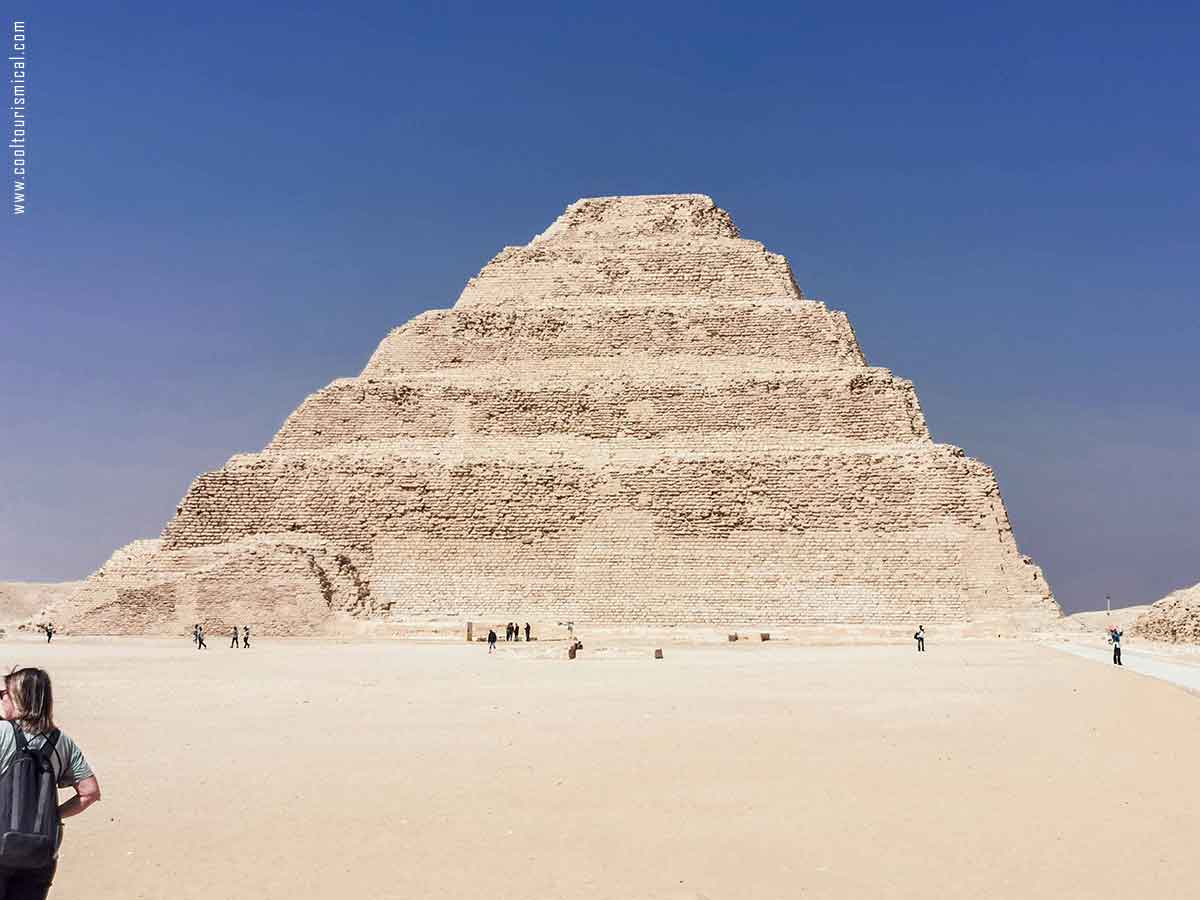
The guide takes you to Memphis, Egypt’s ancient capital, and Saqqara, home to the world’s first pyramid. A complete journey into the roots of civilization!
I tried to cover everything you might need — from how to get there, what are the actual costs, what it feels like to venture on your own compared to hiring a local guide, to what you’ll actually see once you arrive. From entry fees to gas prices, from weather tips to hidden corners — it’s all here, to help you plan your own adventure into the oldest heart of Egypt.
Disclosure: This article contains affiliate links. If you make a purchase after clicking one of these links, I earn a small commission from that website at no extra cost to you. Learn more: Disclosure policy.
 Why Visit Memphis & Saqqara?
Why Visit Memphis & Saqqara?
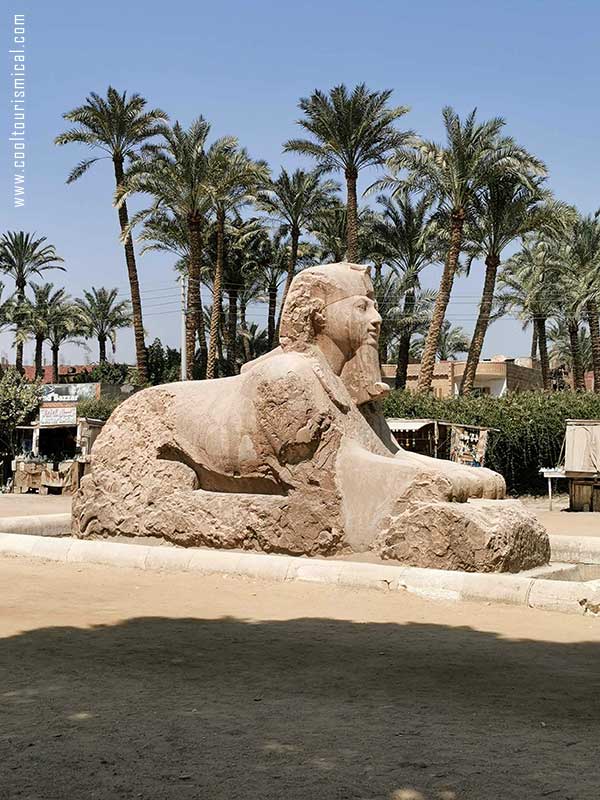
The Sphinx of Memphis (Alabaster Sphinx – 1550-1292 BCE), Copyright © Cooltourismical.com
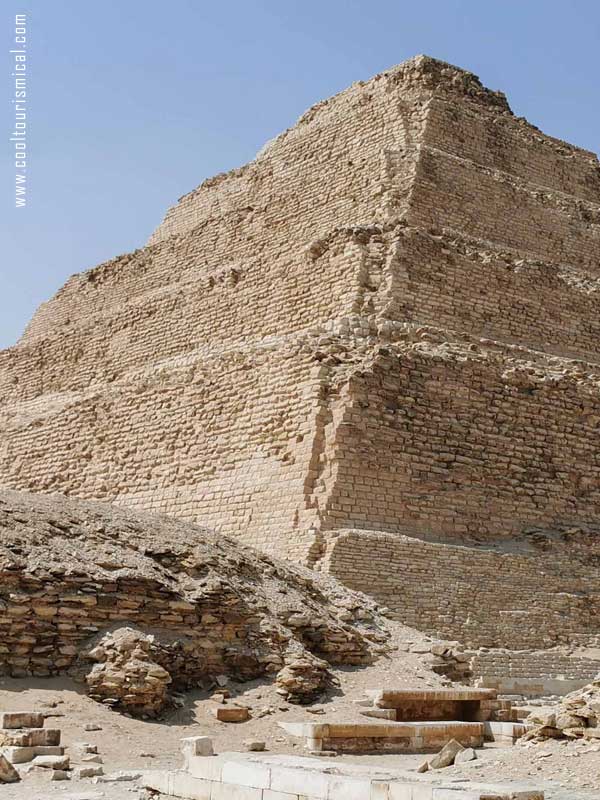
Saqqara Archaeological Site – The very first Necropolis of Egypt, Copyright © Cooltourismical.com
Because this is where it all started.
Before Giza, before all that grand tourism and noisy trinket vendors — there was Memphis, the first capital, and Saqqara, the first-ever necropolis. If you’re already heading to one, it would feel like quite an incomplete trip without seeing the other too.
Memphis was the first capital of Ancient Egypt after the unification of the country. Its history dates back to around 3100 BC, when it was founded by the so-called Pharaoh Menes. Today, everything that’s left is just a peaceful, rather small open-air museum filled, though, with colossal statues.
However, Saqqara is today one of the most fascinating archaeological sites in Egypt, and home to the Step Pyramid of Djoser, the first pyramid ever built. This area was Memphis’s royal necropolis, the place where all its elites were brought to be buried for over 3,000 years.
📌 The two destinations seem meant to be visited in one go— especially as they are only 15–20 minutes by car from each other, in the same direction, just south of Cairo.
 How to Get There
How to Get There
- 📌 Distance from Cairo: Memphis is at around 30 km and Saqqara at 35 km distance. That’s about 45–60 minutes by car from the city center.
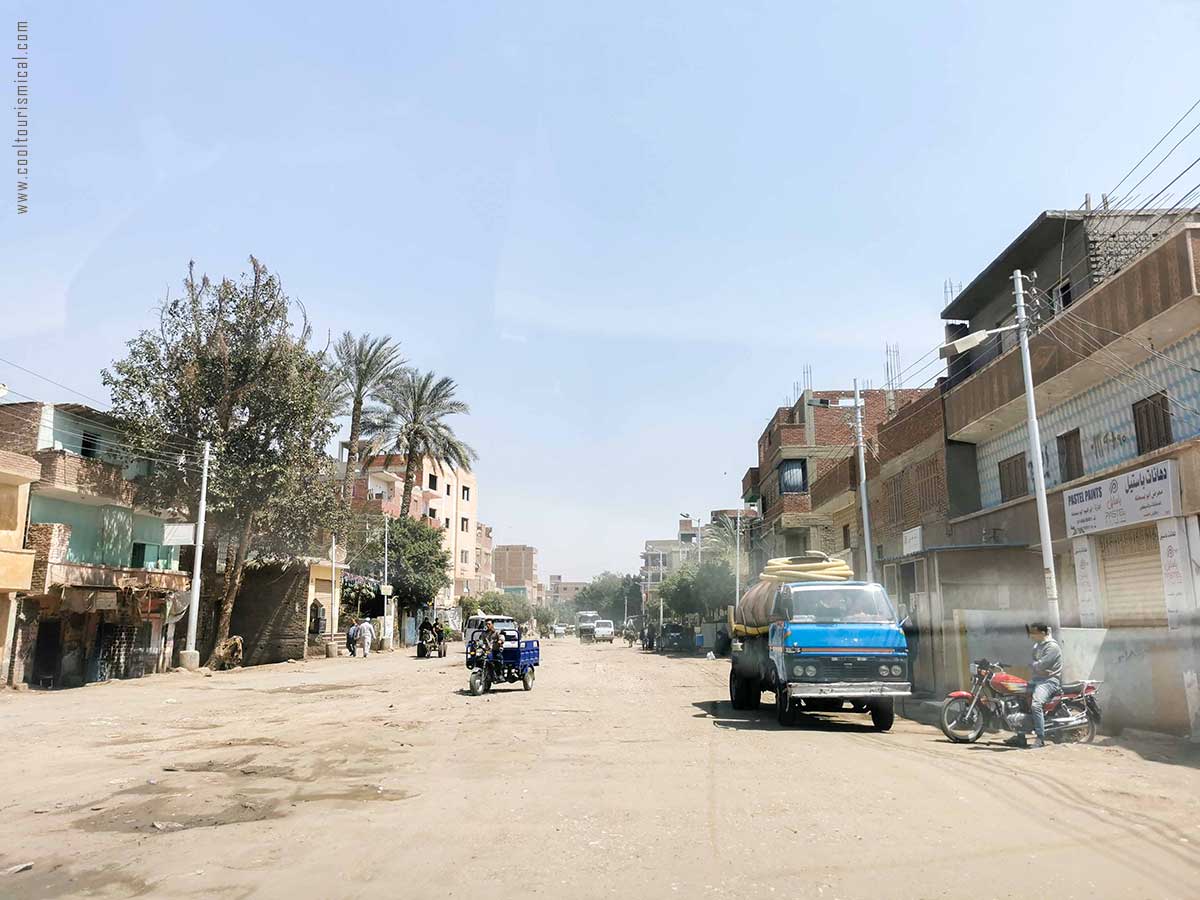
Getting lost on our way to Memphis – Mit Rahina Village, Egypt, Copyright © Cooltourismical.com
You have multiple options available to reach Memphis and Saqqara from Cairo. But, in the end, all of them come down to one simple truth: you will definitely need a car! That happens because no public transport reaches these ancient corners of Egypt. And the desert roads aren’t the best either.
To get from Cairo first to Memphis and then on to Saqqara, I rented a car. At the time, it seemed like the most flexible and comfortable way to do the trip. I just wanted to take my time, make stops along the way, and explore the whole areas which is surrounded by farmlands and small cities.
But be ready: at least within Cairo, the traffic can be such a mess.
You can also take an Uber or a taxi, but this is less reliable when you have in mind a trip with multiple stops. Which brings us to the best options: booking either a personal driver or a guided tour.
⌚ Organized Tours: usually, last around 6 hours for Memphis and Saqqara only. More, if you add Giza.
 Memphis & Saqqara Day Trip Itinerary (On Your Own)
Memphis & Saqqara Day Trip Itinerary (On Your Own)
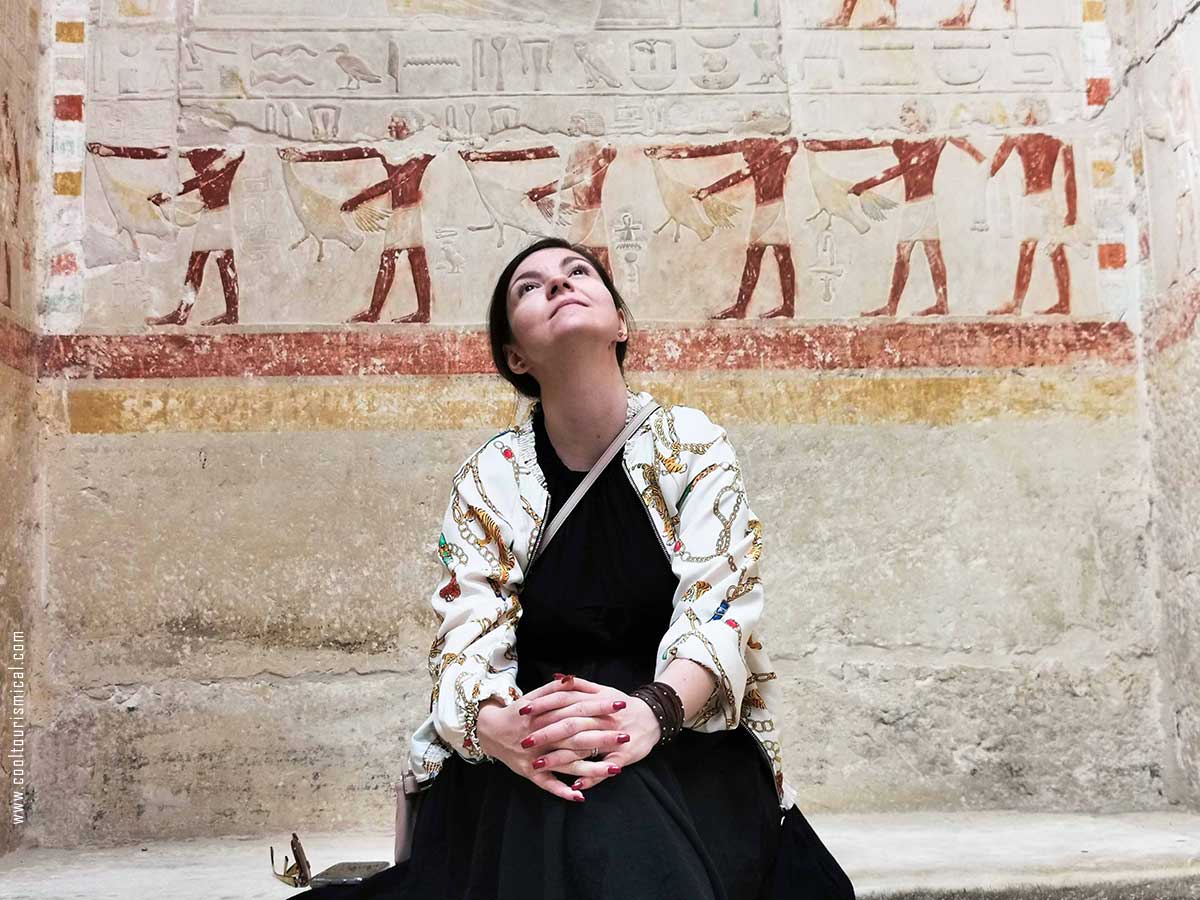
Inside the Tomb of Princess Sesheshet Idut, 6th dynasty. ca. 2330 BCE, Saqqara, Copyright © Cooltourismical.com
We had quite an adventure by driving ourselves in the countryside near Cairo. Two people and an old car getting lost on roads Google didn’t even knew they existed.
And this day trip itinerary to Memphis and Saqqara came straight out of it. It will work perfectly well if you rent a car or hire a private driver.
But if you’d rather sit back and let someone else handle the details, make sure to check guided tours section.
8:30 AM – Depart from Cairo
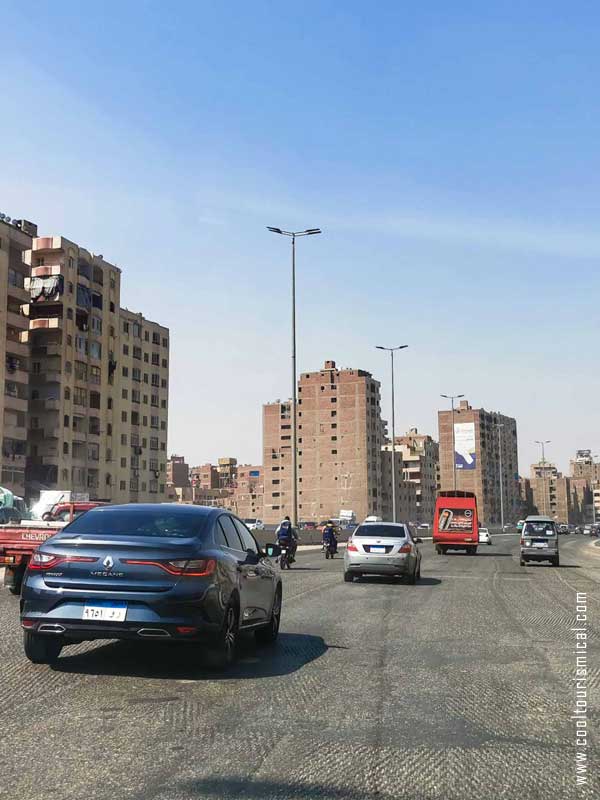
Cairo road to Mit Rahina, Copyright © Cooltourismical.com

Stopped in a village shop for some snacks, Copyright © Cooltourismical.com
I would recommend leaving Cairo by 8:30 AM. Therefore, make sure to rent a car the day before traveling, or try to arrange for a private driver well in advance. Don’t leave behind the sunscreen, a hat, water, and small cash for tips or shopping in the villages along the way. Add also a few snacks to keep you going in between stops.
9:30 AM – Arrive at Memphis (Mit Rahina Village)
- 🎟️ Entrance fee: EGP 200 / person | Duration: 30–45 minutes | Open: from 8 a.m. to 4 p.m.
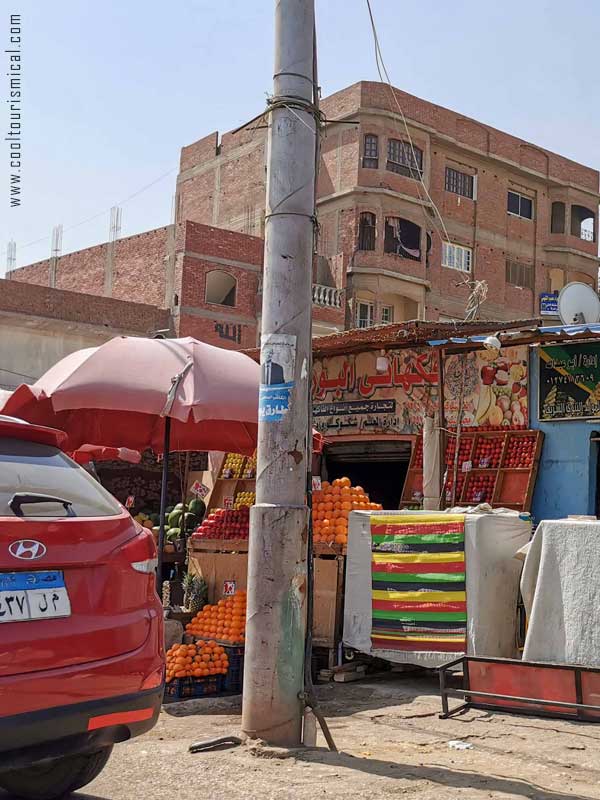
Cairo road to Mit Rahina, Copyright © Cooltourismical.com
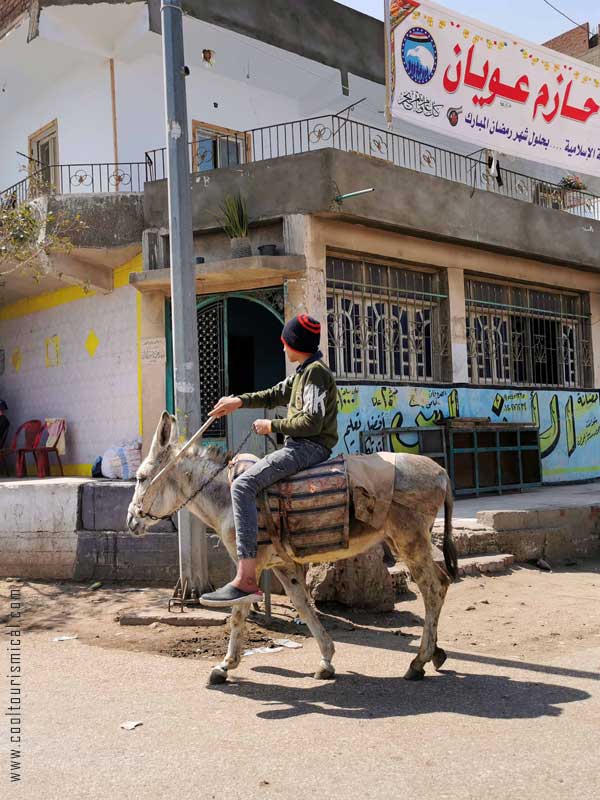
Stopped in a village shop for some snacks, Copyright © Cooltourismical.com
More than 3000 years ago, Memphis (was known as Inbu-hedj or “The White Walls”) was thriving as Egypt’s greatest city.
For a long time, just like modern Cairo, ancient Memphis was quite cosmopolitan, with temples, settlements, and palaces, most of them built during the reign of Ramses II, one of Egypt’s most powerful pharaohs.
The city served as the seat of government for six dynasties, until it slowly began to fade with the rise of Alexandria. There is not much left of Memphis today. Even if, at its peak, the ancient capital stretched far beyond the small, gated archaeological park you will see there.
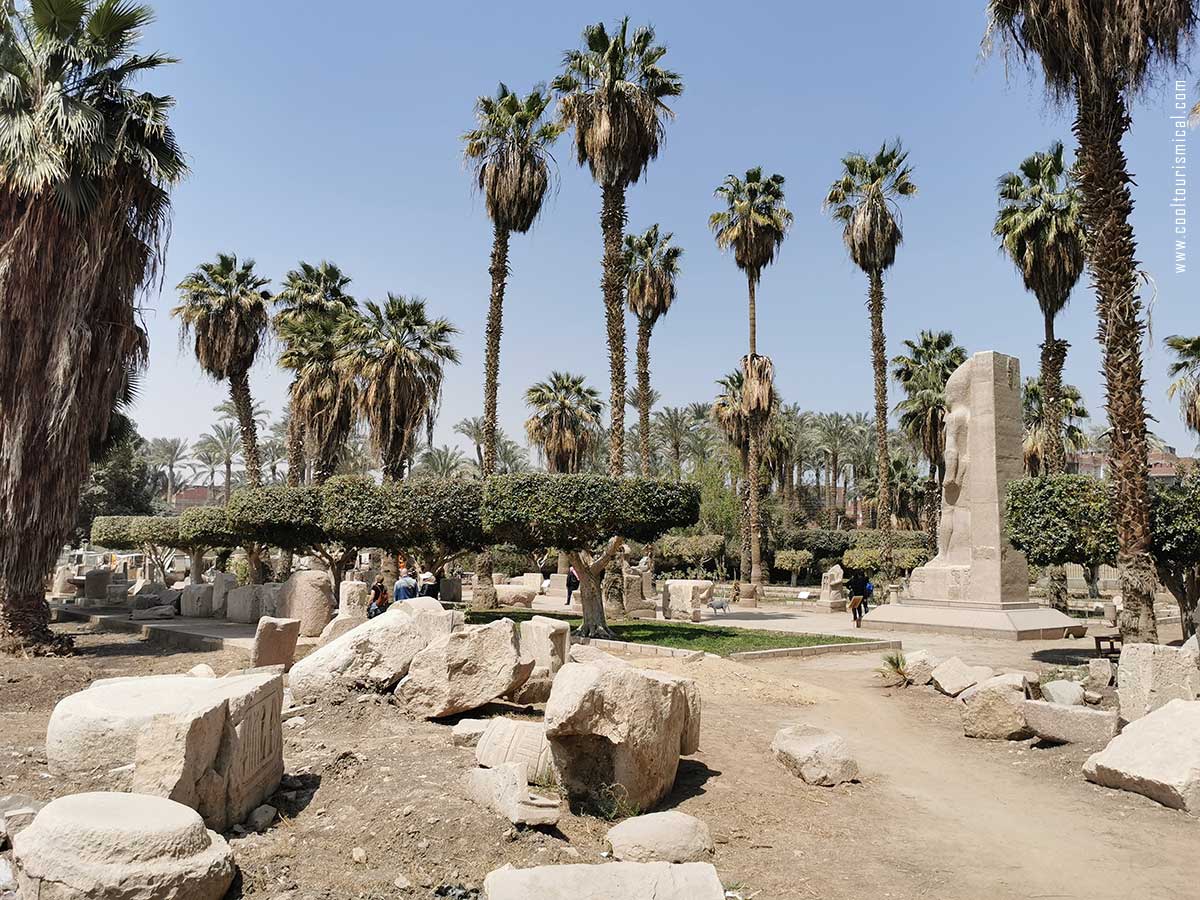
Memphis Archaeological Site, Copyright © Cooltourismical.com
The old structures have disappeared. Earthquakes, political uprisings, and looting brought them irreversibly down, while time and grass slowly creeped in and reclaimed the lands.
What survives is scattered—part is half-hidden beneath the sleepy village of Mit Rahina, while the rest is just an outdoor repository with all kinds of artefacts and ghosts. Countless broken fragments sitting in a garden with dusty roads, in the shade of tall date palms and sycamore figs.
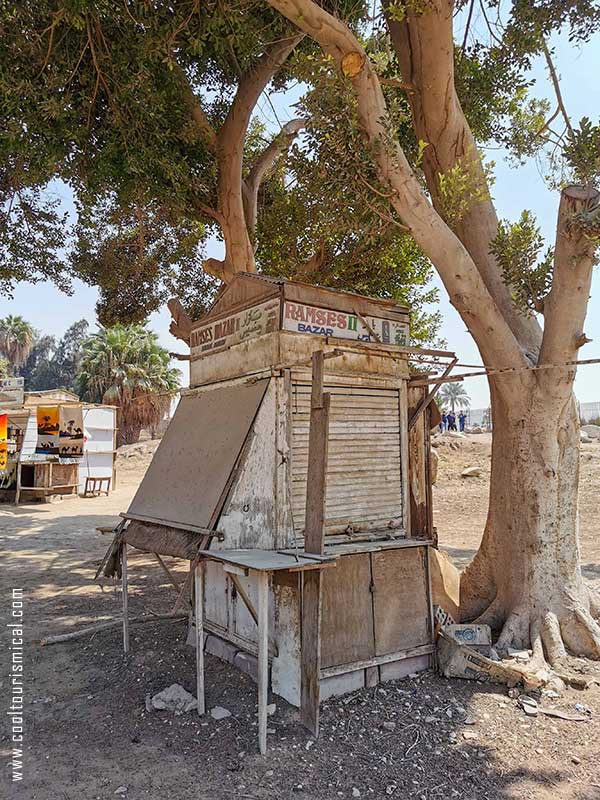
Memphis Bazaar, Copyright © Cooltourismical.com
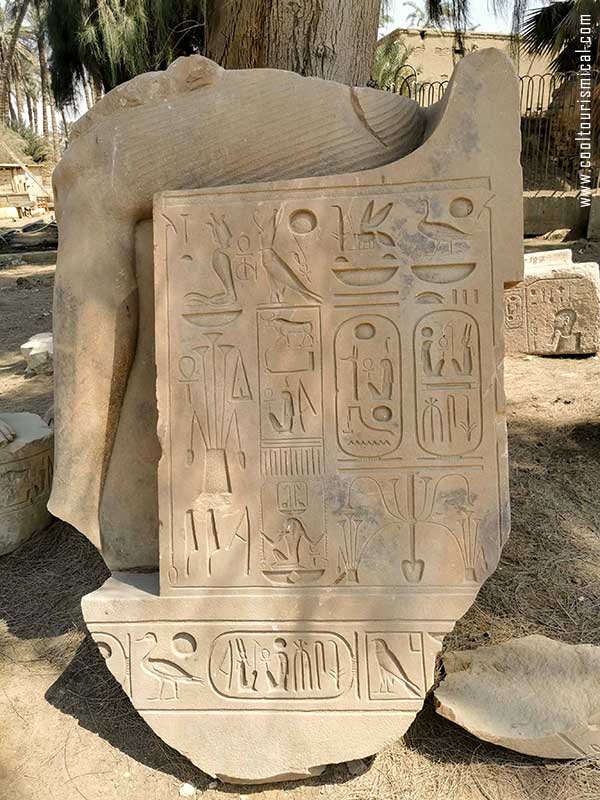
Artefact on the site, Copyright © Cooltourismical.com
“MEMPHIS. Since 3300 BC or earlier. Talking about Egypt without mentioning Memphis is like talking about Italy without reference to Rome.’ So proclaims a weathered info board, half-faded by sun and time, right at the entrance of the small museum in Mit Rahina.
The centerpiece of this version of Memphis is a colossal statue of Ramses II, over 10 meters long, which is lying horizontally inside a pavilion built around it. A raw-stone sleeping king whose toes alone feel larger than your head.
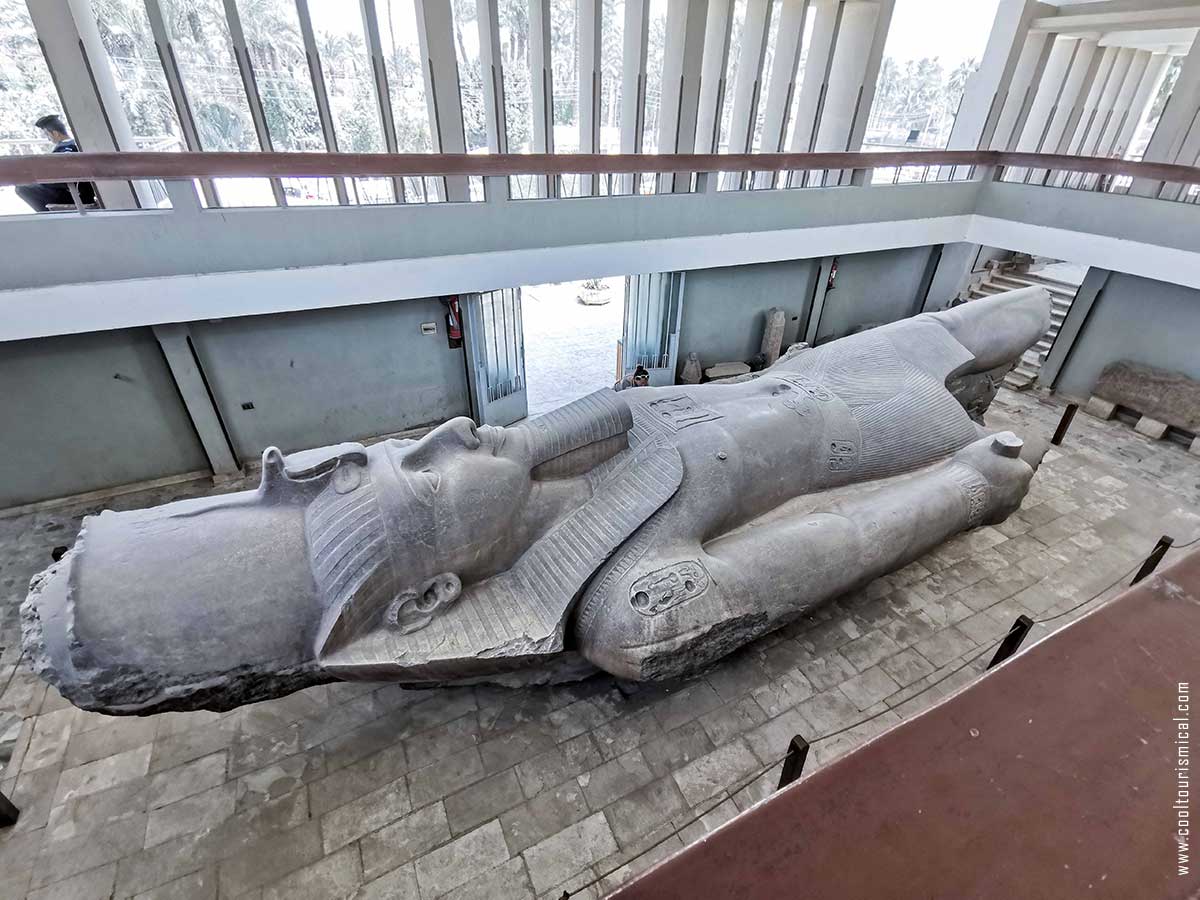
Colossal Statue of Ramses II, Copyright © Cooltourismical.com
🌴 What to see in Memphis:
- Colossal Statue of Ramses II: Found face-down in a field in 1820 and now housed in a pavilion. The statue is 10.7 meters long and impressively detailed.
- Alabaster Sphinx of Memphis: Smaller than the Giza Sphinx but made of white calcite alabaster — possibly represents Hatshepsut or Amenhotep II.
- Other scattered statues and stones blocks of the Temple of Ptah, the patron god of Memphis.
10:30 AM – Drive to Saqqara (15–20 minutes)

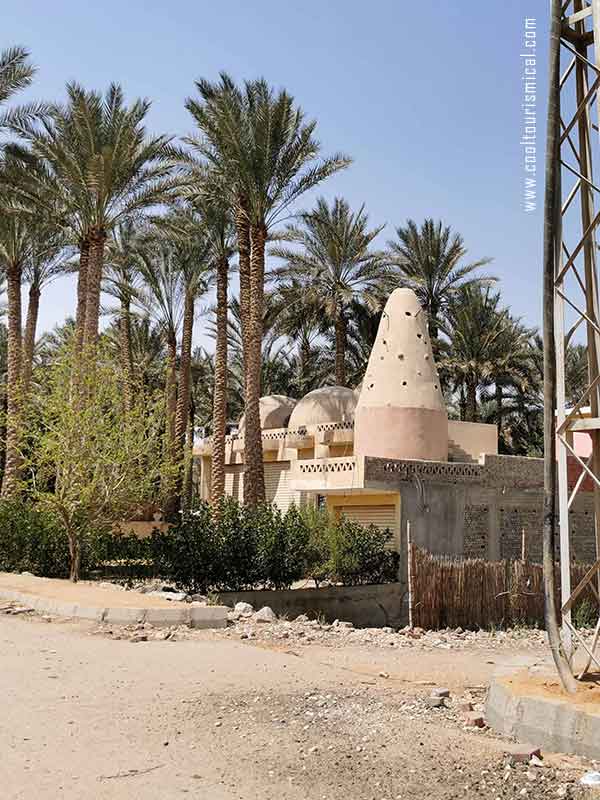
Egyptian Villages near Saqqara, Copyright © Cooltourismical.com
In order to reach Saqqara from Memphis, you’ll have to drive through the rural farmland. And that’s a region that seems hundreds of years apart from the busy Cairo.
To be honest, we got completely lost with our rented car and no guide. Google Maps was of no help. It showed roads that either didn’t exist or were almost impossible to access with a car. I remember that, at one point, we were so off track it felt like we were heading directly into one of those old biblical movies. Minus the soundtrack, I swear! Narrow paths, dust, and locals all covered up from head to toe, riding donkeys. Smell of grass and diesel, both magical and slightly unsettling.
11:00 AM – 2:00 PM – Explore Saqqara Necropolis: The Birthplace of Pyramids
- 🎟️ Entrance fee: EGP 600 / person | Duration: 2-3 hours | Open: from 8 a.m. to 5 p.m.
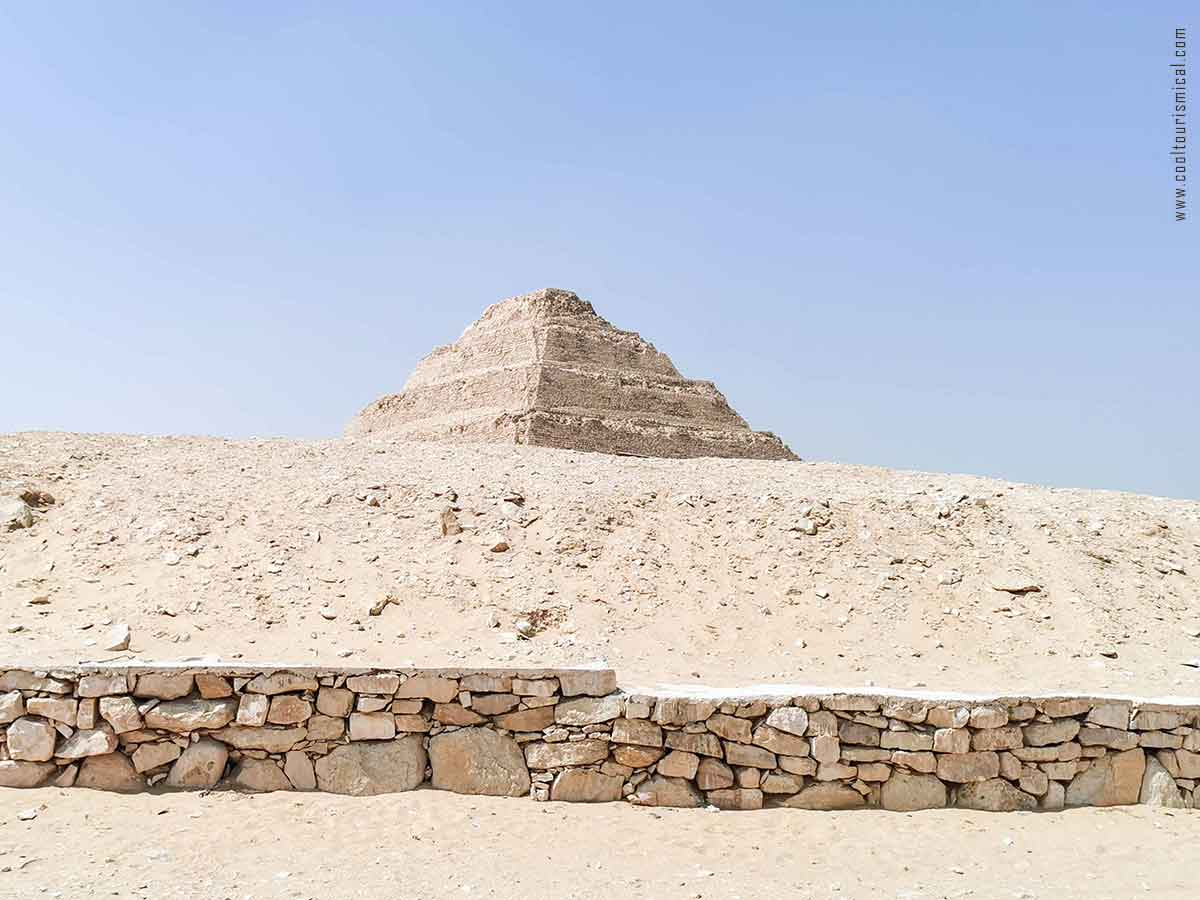
Visiting Saqqara Pyramids – Djoser Pyramid View, Copyright © Cooltourismical.com
Saqqara was once the vast cemetery of ancient Memphis. But also the place where it all began, the story of the pyramids. Its most iconic landmark, the Step Pyramid of Djoser, still stands as Egypt’s very first attempt to reach for the heavens while building massively in stone.
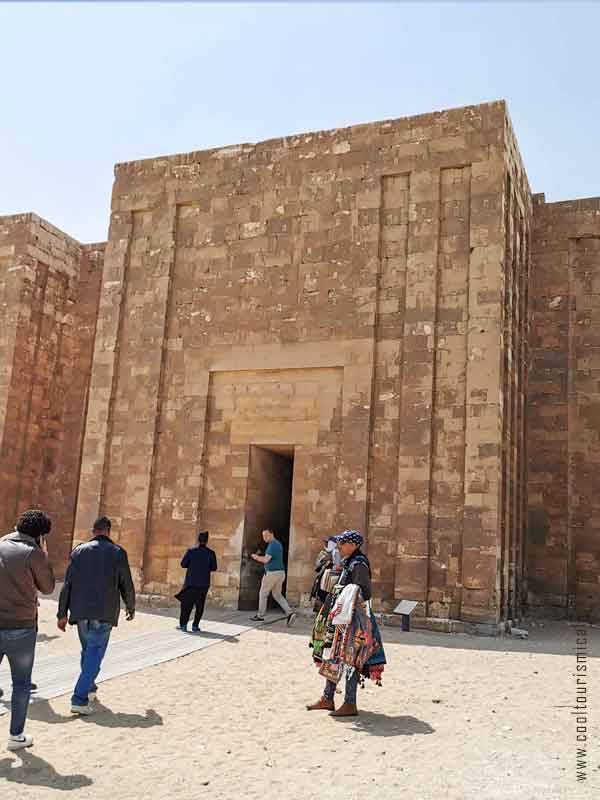
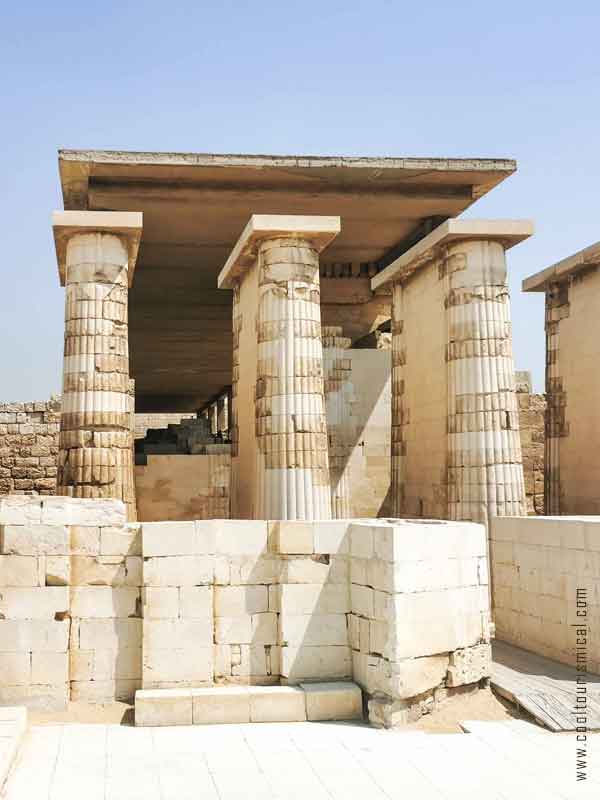
Enclosure wall and colonnade entrance to Djoser Pyramid Complex, Copyright © Cooltourismical.com
Getting closer to it, the scenery changes once again. The entire archaeological complex of Saqqara rises from the desert, and somehow, it has the mysterious vibe of a ruined temple city rather than of a necropolis.
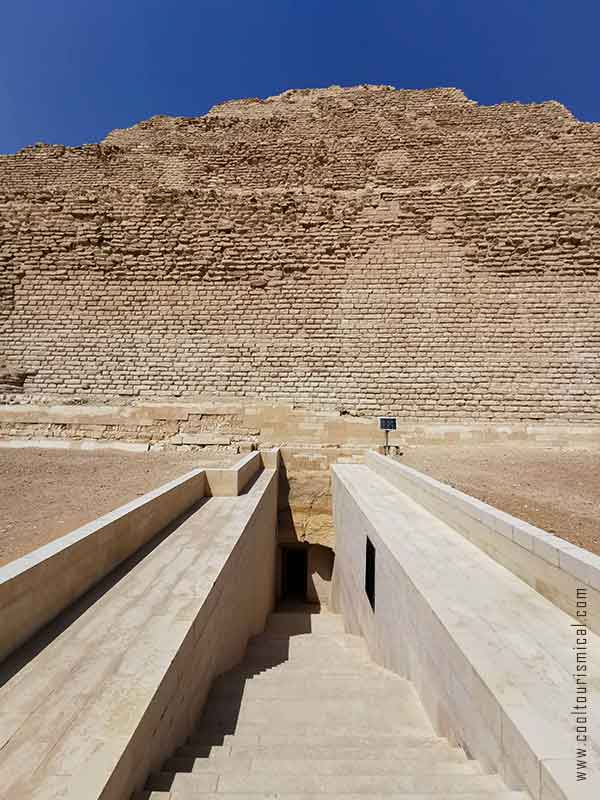
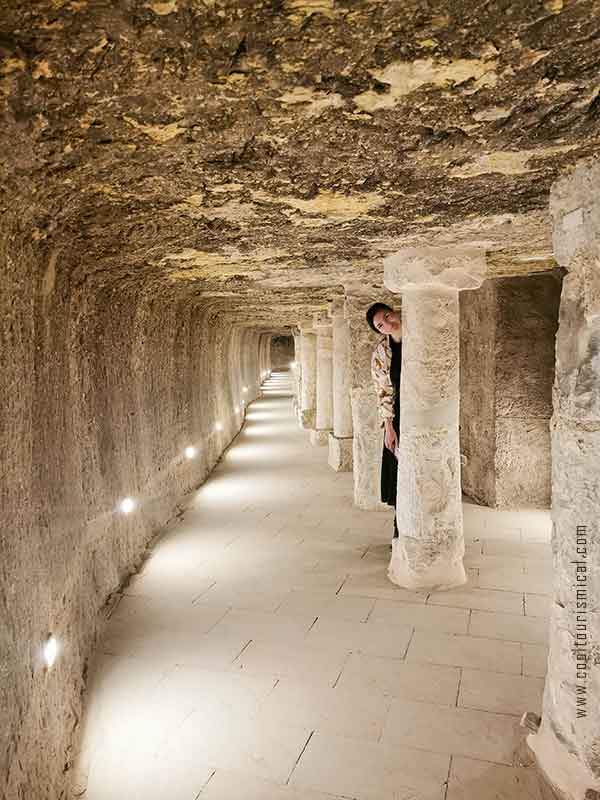
South Entrance of Djoser Pyramid in Saqqara, Copyright © Cooltourismical.com
The 4,500-year-old Step Pyramid, the tombs of nobles hidden behind crumbling facades, plus a labyrinth of underground tunnels, all felt completely raw, ancient, and obviously insufficiently explored. It felt like a living excavation site. You could literally touch the structures half-swallowed by the sand, brush them off with your hands and uncover hieroglyphs.
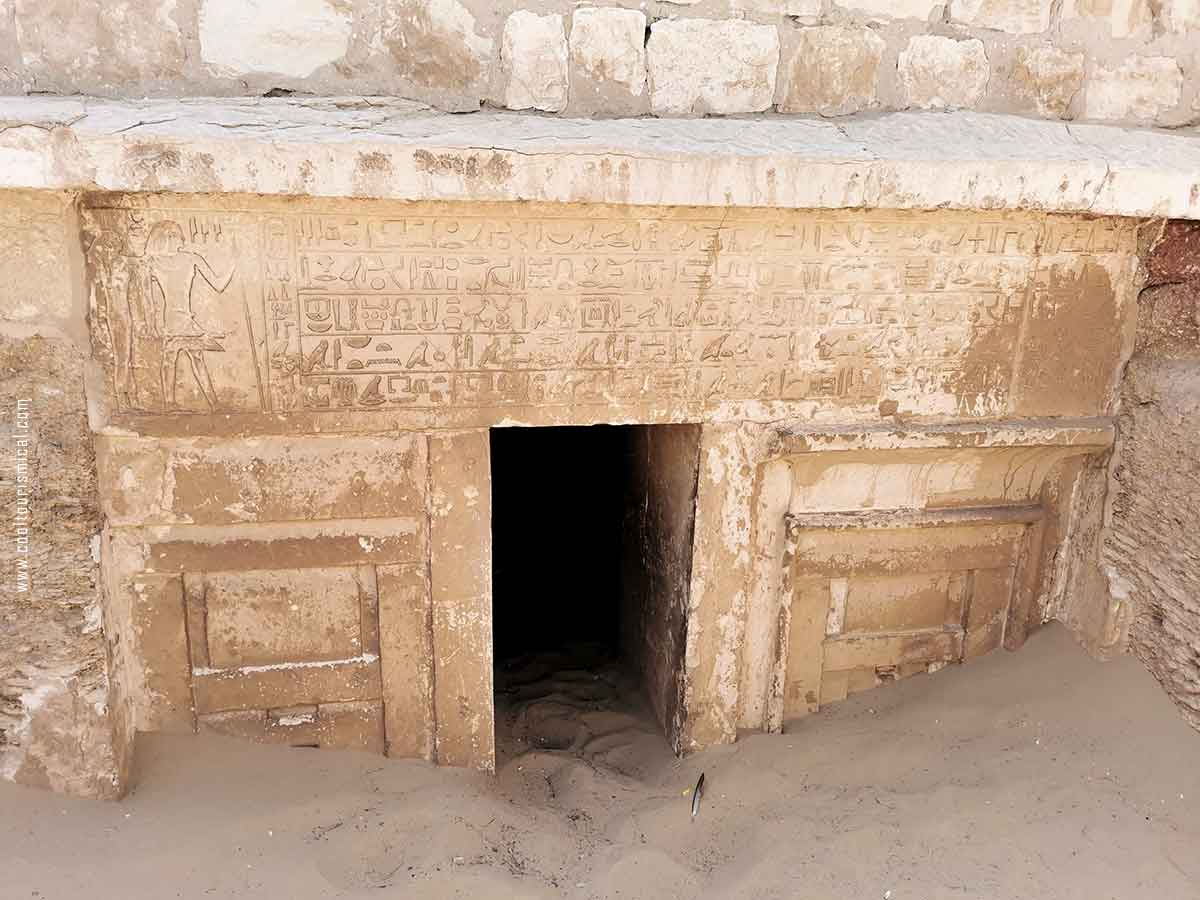
Half-Buried Tomb in Saqqara Archaeological Site, Copyright © Cooltourismical.com
I think you’ll easily spend there at least a couple of hours. Maybe more. Especially in this eerie, parallel universe to Giza, where the desert hasn’t yet given up all its secrets yet.
There is a parking available on-site (25 EGP/car), and the entire area feels much less crowded than Giza. However, tip requests can still be a bit persistent.
🪧Top highlights in Saqqara:
- Step Pyramid of Djoser: You could consider it as the architectural-scale “prototype” for pyramids. It was built in ~2667–2648 BC, for Pharaoh Djoser, by architect Imhotep, as the first stone monument and earliest pyramid structure in Egypt. Its impressive stone doorways, with fake hinges, were carved to trick the spirits. You can go inside with an additional ticket (280 EGP).
- Imhotep Museum (included in ticket): Modern, air-conditioned, and with the information needed displayed. There are some artifacts from the site, including mummies, ancient tools, and a statue of Imhotep himself.
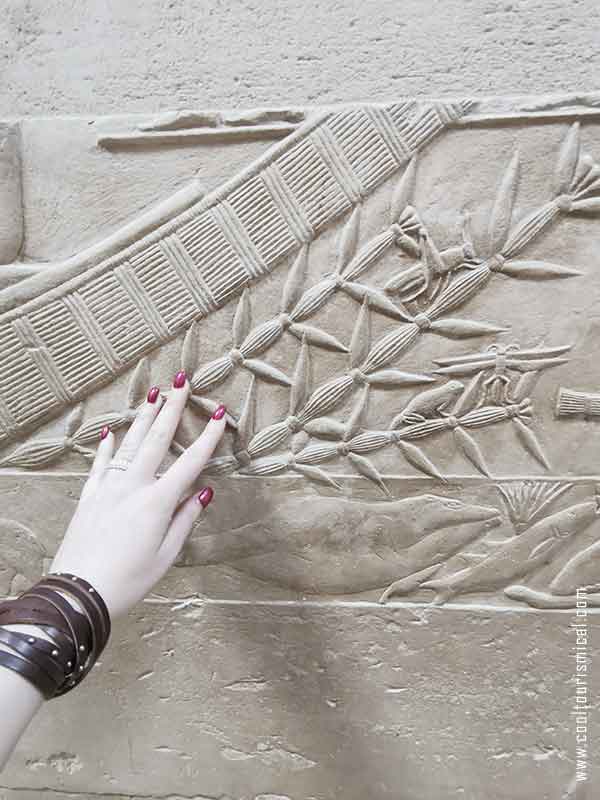
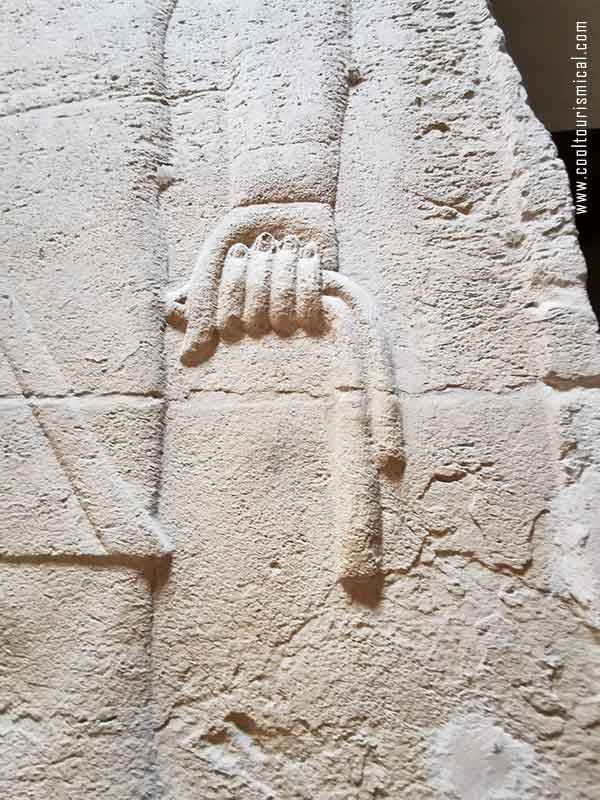
Tomb of Kagemni, Chief of Justice and Vizier (c.2345-2323 BC), Copyright © Cooltourismical.com
- Mastaba of Ti: Ti was a high-ranking official during the 5th Dynasty. Scenes inside his tomb, one of the most spectacular of the Old Kingdom, are showing how daily life used to be — agriculture, boating, butchery — in ochre and faded green. Ticketed separately, ~300 EGP.
- Tomb of Mereruka: It is among the largest mastabas in Saqqara, a maze of about 32 rooms, with some with vivid wall paintings and low relief carvings. Ticketed separately, ~200 EGP.
- Serapeum of Saqqara: The massive underground catacombs where sacred Apis bulls were buried. These were worshipped as incarnations of the god Ptah. And their enormous granite sarcophagi weigh up to 70 tons each. They are so huge that it’s still a mystery how they were transported under the ground. Atmospheric and eerie. Ticketed separately, ~300-400 EGP.
📌 Tips & Tricks: All-tombs inclusive ticket is 1000 EGP. Guards may offer to unlock less-visited tombs for a small tip (~20–50 EGP).
2:00 PM – Lunch Break Nearby

Image courtesy of Djoser Oasis Restaurant
By now, the heat is already pressing on your shoulders and all you an think of is probably hieroglyphs. Thankfully, lunch is not so far away.
There are multiple restaurants in the area. Djoser Oasis (200-300 EGP/ person) is one of the good ones: quiet restaurant, shaded by palms. They serve simple, traditional dishes like grilled chicken, tahini, warm baladi bread that will actually feel like a blessing after such a long walk. And the mint tea is hot and sweet as it should.
📌 Alternatives: Blue Lotus, Bayet Elref Restaurant (500-600 EGP / person), and Saqqara Palm Club.
3:00 PM – Optional: Dahshur (if you have energy)
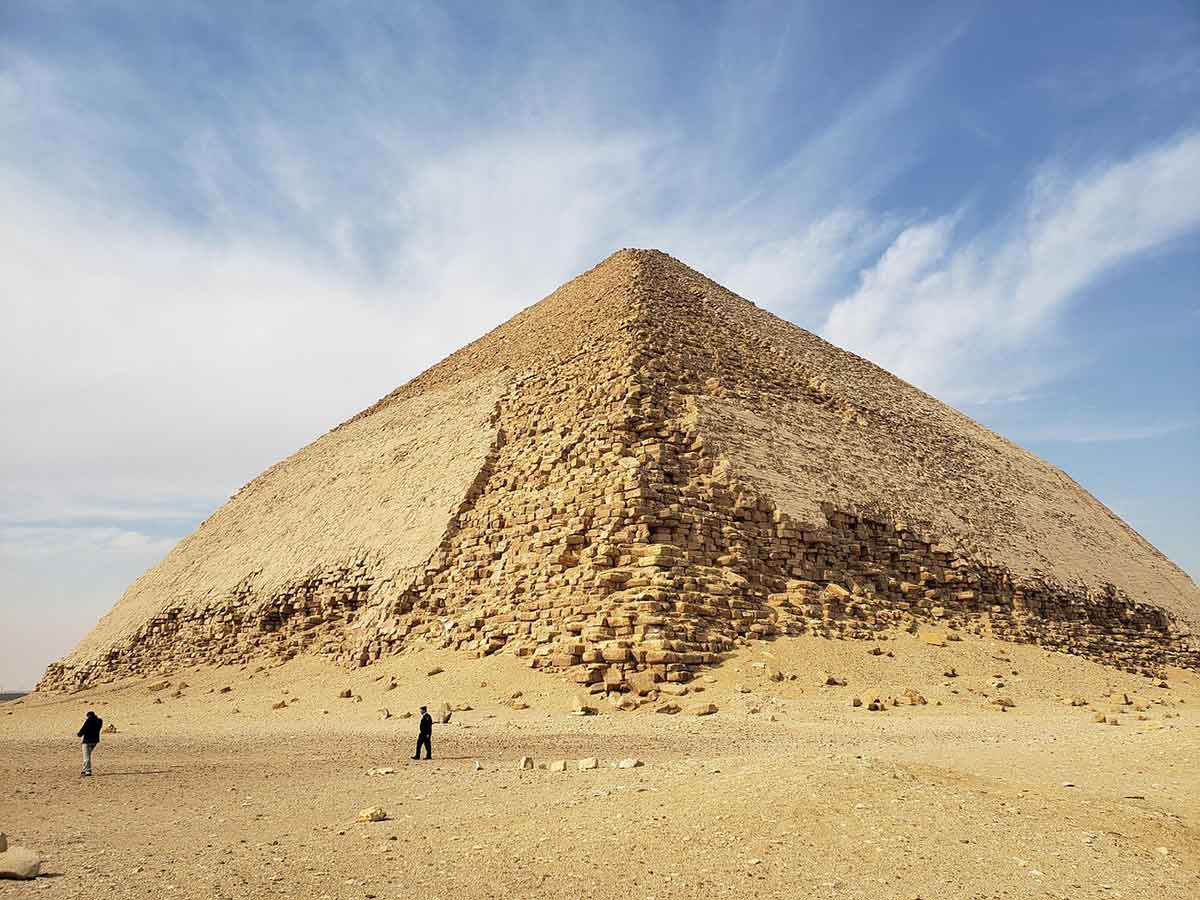
If time allows, don’t skip Dahshur. It’s another, even wilder necropolis, where the stars are the Bent Pyramid, leaning a bit awkwardly, and the Red Pyramid, covered in rusty reddish hue.
Built by Pharaoh Sneferu, these were some of Egypt’s first experiments in true pyramid construction. Their destiny was never fulfilled, because they had multiple structural mistakes, generating potential instability issues. Raw, dusty, and far more thrilling than polished Giza, Dashur pyramids have some rough connecting passages, sliding ramps leading intro claustrophobic darkened chambers, and scattered stone blocks you will need to climb to make your way out. More fun than Giza, true, but also riskier.
4:30–5:00 PM – Return to Cairo
- 🎟️ Drive time: ~1 hour back depending on traffic
It is best to return before dark if you’re driving yourself. In rural areas the streetlights, as well as signage is rare.
While you’ll do your best not to get lost, the drive back will be quiet and magical. All the limestone lions, mysterious tombs, reliefs of oxen, shattered doorways, the Egypt that breathes behind the postcards, will stay behind.
 Best Memphis & Saqqara Guided Tours
Best Memphis & Saqqara Guided Tours
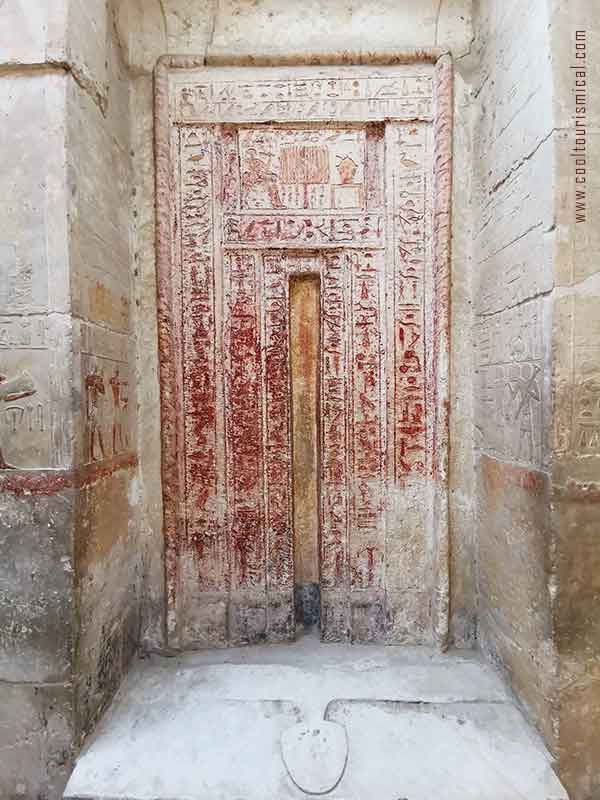
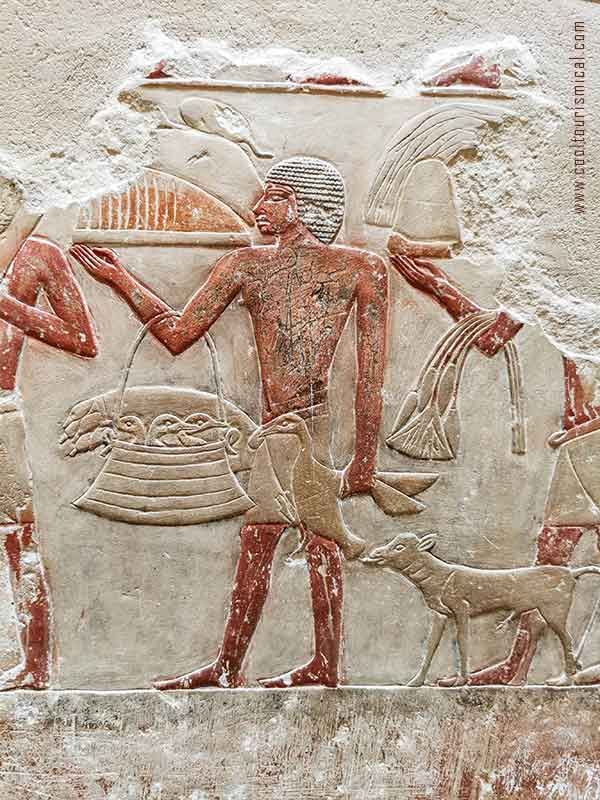
Egyptian hieroglyphs, Copyright © Cooltourismical.com
I found some amazing (and quite affordable) guided tours of Memphis and Saqqara on Viator, as well as on GetYourGuide.
And honestly, after my own (first) experience at the pyramids, I wouldn’t do it any other way. Having a local guide made all the difference. I could access the monuments without the pressure of the extra tips, the locals were far less aggressive, and I felt safer, and more at ease to walk around, take pictures. Plus, more importantly, I was told what was worth seeing and what could be skipped. Because there was so much out there.
These tours below pair you sometimes with real Egyptologists ready to tell stories that can bring a broken wall carving back to life, or local people who know where the hidden tombs lie, and who time your visit in such way the light catches the Step Pyramid just right. They will pick you up from the hotel, with a clean car, and save you the time and the trouble of getting lost in no one’s land.
Plus, all the entrance fees are usually covered from the start, so you won’t have to carry a lot of cash with you or stop to pay at every single monument along the way. Which can be crazy!
📌 This tour, for example, Private Day Tour to Memphis Sakkara and Dahshur from Cairo, is very well rated and it takes you from crumbling tombs and hidden hieroglyphs to the towering Bent Pyramid and the silent colossus of Ramses II. You can visit all three locations, at your own pace, solo or with your group only, plus a local guide.
 Final Tips & Tricks for Planning Your Day Trip
Final Tips & Tricks for Planning Your Day Trip
Memphis, the ancient capital covered by grass. Saqqara, the first pyramid standing alone in the desert, plus tombs not just of kings, but of bakers and boatmen, scribes and singers.
You won’t see crowds there. You won’t find those souvenir stalls or light shows like in Giza. But you’ll find something far less common: the birthplace of Egyptology itself, and the remains of the Old Kingdom’s earliest ambitions, much of them still under a thick blanket of sand.
It is totally worth a day trip from Cairo to Memphis and Saqqara. Just plan it wisely.
- ⏰ Best time to visit: October to mid May for cooler temperatures. Avoid midday heat in summer.
- 📌 Dress code: Modest and breathable clothing, light colours. Closed shoes recommended.
- 📌 Bring with you: small cash, sunscreen, hat, a lantern for the underground, water and snacks.
- 🎟️ Photography: Allowed outside and in most tombs, but, as expected, flash is often prohibited.
- 🎟️ Guides: You can hire local guides at the entrance (~300–500 EGP for a private tour).




